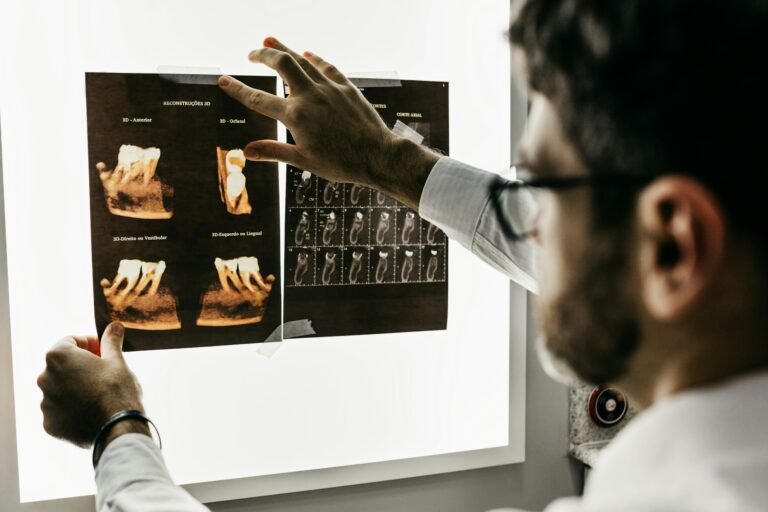Table of Contents
The Evolution of Dentistry: A Look Back at the Past

Dentistry, as we know it today, has come a long way from its humble beginnings. The field has evolved significantly over the years, incorporating advancements in technology, techniques, and knowledge. The early practices of dentistry were primarily focused on relieving pain and extracting teeth, often without the use of anesthesia or sterile instruments. However, as our understanding of oral health grew, so did the field of dentistry.
One of the major milestones in the evolution of dentistry was the discovery of the importance of oral hygiene. In the late 19th century, dental professionals realized that practicing proper oral hygiene could prevent tooth decay and gum disease. This led to the development of toothpaste, toothbrushes, and dental floss, which became essential tools for maintaining good oral health. Additionally, the understanding of the link between oral health and overall health began to emerge, highlighting the importance of regular check-ups and preventive care.
As the field of dentistry advanced, so did the techniques and materials used in dental procedures. Innovations such as the introduction of local anesthesia, X-rays for diagnosis, and the use of dental implants revolutionized the way dentists could treat their patients. These advancements not only improved the comfort and safety of dental procedures but also allowed for more durable and natural-looking restorations.
The evolution of dentistry is an ongoing process, with new technologies and treatments constantly being developed. From the introduction of lasers for soft tissue procedures to the use of digital scanners and 3D printers for creating precise dental restorations, the field continues to push the boundaries of what is possible. With each new advancement, dentistry becomes more efficient, effective, and patient-friendly.
In the next section, we will delve deeper into the advancements in dental technology and how they have transformed the patient experience. From improved diagnosis to more comfortable treatment options, these innovations have revolutionized the way we approach dental care. Join us as we explore the exciting world of modern dentistry and the transformative impact it has on patients’ lives.
Advancements in Dental Technology: Transforming the Patient Experience




Advancements in dental technology have reshaped the patient experience, revolutionizing the field of dentistry. From improved diagnostic tools to cutting-edge treatment options, these advancements have transformed the way dental professionals approach patient care.
One major area of advancement is in the realm of digital dentistry. Utilizing technologies such as intraoral scanners, dentists can now capture highly accurate, 3D images of a patient’s teeth and gums. This not only eliminates the need for messy, uncomfortable dental impressions, but it also allows for more precise treatment planning and better communication between the dentist and the dental lab. Additionally, digital dentistry has paved the way for computer-aided design and computer-aided manufacturing (CAD/CAM) systems, enabling the creation of same-day dental restorations like crowns and veneers. Patients can now have their teeth restored in a single visit, saving them time and reducing the need for multiple appointments.
Another significant advancement is the integration of artificial intelligence (AI) in dental care. AI algorithms can analyze vast amounts of patient data and radiographs, assisting dentists in accurately diagnosing conditions such as cavities, gum disease, and oral cancer. AI-powered tools can also aid in treatment planning, predicting treatment outcomes, and improving overall treatment efficiency. By harnessing the power of AI, dentists can provide more accurate diagnoses and personalized treatment plans, ultimately enhancing the patient experience and oral health outcomes.
Overall, these advancements in dental technology have transformed the patient experience by streamlining processes, improving accuracy, and enhancing treatment outcomes. As technology continues to evolve, we can expect even more exciting innovations that will further revolutionize the field of dentistry, ultimately improving overall oral health for patients worldwide.
Improving Diagnosis and Treatment with Digital Dentistry




Digital dentistry has revolutionized the field of diagnosis and treatment by offering more accurate and efficient methods. This cutting-edge technology utilizes digital tools and imaging techniques to enhance the dental experience for both patients and dentists. With the use of digital radiography, for example, dentists are able to capture high-quality images of patients’ teeth and oral structures, allowing for a more detailed analysis of potential issues.
The benefits of digital dentistry go beyond just improved diagnosis. It also streamlines the treatment process by providing dentists with precise measurements and data. For instance, digital impressions allow for the creation of virtual models of patients’ teeth, eliminating the need for messy traditional molds. This not only improves patient comfort, but it also enables dentists to create more accurate and customized treatment plans.
With the integration of digital dentistry into the practice, dentists are able to make more informed decisions and provide more effective treatments. By embracing this evolving technology, the field of dentistry continues to push boundaries and enhance patient care.
The Role of 3D Printing in Dentistry: Enhancing Precision and Efficiency
Dentistry has come a long way in recent years, with advancements in technology revolutionizing the way dental professionals approach patient care. One such technology making a significant impact is 3D printing. The role of 3D printing in dentistry is enhancing precision and efficiency, allowing for more accurate and personalized treatments.
Traditionally, dental prosthetics and appliances were crafted by hand, a labor-intensive process that often resulted in inconsistencies and long lead times. With 3D printing, dental professionals can now create precise and customized dental restorations, such as crowns, bridges, and even orthodontic aligners, with ease and speed. This technology enables dentists to capture digital impressions of the patient’s teeth and manufacture highly accurate models, which can then be used to create the final restoration. The result is a more precise fit, reducing the need for adjustments and improving patient comfort.
Moreover, 3D printing in dentistry facilitates greater efficiency in treatment planning and execution. With the ability to digitally design and fabricate dental restorations, the time-consuming process of traditional manual wax-ups is eliminated. Dentists can now visualize and manipulate the final restoration virtually before printing, ensuring optimal aesthetics and function. This streamlined workflow not only saves valuable time but also minimizes material wastage, leading to cost savings for both the patient and the dental practice.
In conclusion, 3D printing is transforming the field of dentistry by enhancing precision and efficiency. By leveraging this technology, dental professionals can achieve higher levels of accuracy in their treatment planning and provide patients with personalized and comfortable care. As 3D printing continues to evolve, we can expect even greater advances in dental technology, further improving the overall oral health outcomes for patients.
The table below provides a concise overview of the Role of 3D Printing in Dentistry.
| Aspect | Role of 3D Printing in Dentistry |
|---|---|
| Customization | Enables the creation of customized dental implants, crowns, bridges, and orthodontic devices tailored to the patient’s unique oral anatomy for better fit and functionality. |
| Precision | Allows for the production of highly precise dental models, surgical guides, and prosthetics, ensuring accurate placement and alignment during dental procedures. |
| Efficiency | Streamlines the dental workflow by reducing manual labor and turnaround times for manufacturing dental appliances, leading to improved efficiency in patient care. |
| Patient Comfort | Enhances patient comfort and satisfaction by minimizing discomfort during dental procedures through the creation of more comfortable and better-fitting dental devices. |
| Innovation | Facilitates innovation in dental treatment approaches, enabling the development of advanced dental solutions and techniques for improved patient outcomes and experiences. |
| Education | Supports dental education and training by providing dental students and professionals with hands-on experience in designing, producing, and using 3D-printed dental models. |
| Cost-effectiveness | Offers cost-effective solutions for dental practices by reducing material waste and the need for expensive equipment, leading to potential cost savings in the long run. |
| Research | Advances dental research by enabling the rapid prototyping and testing of new dental materials, devices, and treatment methods in a controlled and customizable manner. |
Telemedicine in Dentistry: Bridging the Gap for Remote Patients
Telemedicine has transformed the healthcare landscape, allowing patients to receive medical care from the comfort of their own homes. This innovative approach has also made its mark in dentistry, bridging the gap for remote patients who may not have easy access to dental clinics. With telemedicine, patients can now connect with dentists through secure video consultations, enabling them to receive guidance, diagnoses, and even treatment recommendations without leaving their homes.
One of the key advantages of telemedicine in dentistry is its ability to provide convenient access to dental care for individuals residing in remote areas. Often, individuals living in rural or underserved communities face significant challenges when it comes to accessing dental services. Telemedicine eliminates these barriers by allowing patients to connect with dentists virtually, making it easier for them to receive the care they need. This not only improves patients’ oral health outcomes but also reduces the burden on dental clinics and emergency departments. By leveraging technology, telemedicine in dentistry truly bridges the gap for remote patients, ensuring they have timely access to dental expertise and guidance irrespective of their geographical location.
Harnessing the Power of Artificial Intelligence in Dental Care
Artificial Intelligence (AI) has emerged as a game-changer in various industries, and dentistry is no exception. By harnessing the power of AI, dental professionals can revolutionize patient care, improve diagnosis accuracy, and enhance treatment outcomes.
One area where AI is making significant strides is in digital imaging analysis. AI algorithms can quickly analyze dental radiographs, identify abnormalities, and assist in diagnosing conditions such as cavities or periodontal disease. This not only saves time but also enables dentists to provide more accurate and timely treatment plans. Moreover, AI algorithms can learn from vast amounts of data, allowing them to continuously improve their diagnostic accuracy over time.
Another application of AI in dental care is the development of virtual dental assistants. These virtual assistants can provide patients with personalized oral hygiene instructions, remind them of upcoming appointments, and even answer basic dental-related questions. By harnessing the power of AI, dental practices can improve patient engagement, increase adherence to oral care recommendations, and ultimately enhance oral health outcomes.
In conclusion, the power of artificial intelligence in dental care cannot be overstated. From improving diagnosis accuracy to enhancing patient engagement, AI has the potential to transform the way dental professionals deliver care. As technology continues to advance, it is crucial for dental practitioners to embrace these innovative solutions and leverage AI to provide the highest level of oral care to their patients.
Innovative Dental Materials: Enhancing Durability and Aesthetics
Innovations in dental materials have revolutionized the way dental treatments are approached, allowing for enhanced durability and aesthetics. Gone are the days when patients had to compromise on the appearance of their dental restorations or worry about their longevity. With the advent of advanced materials, dentists can now provide their patients with solutions that are not only visually appealing but also offer exceptional strength and longevity.
One such material that has gained significant attention in recent years is zirconia. Known for its remarkable strength and biocompatibility, zirconia has become a popular choice for dental crowns and bridges. Its unique properties make it highly resistant to fractures and chipping, ensuring long-lasting restorations that withstand the rigorous demands of daily wear and tear. Additionally, zirconia provides an excellent aesthetic outcome, blending seamlessly with the natural teeth, giving patients a beautiful and natural-looking smile.
Another innovative dental material that has transformed the field is composite resin. This tooth-colored material is widely used for direct dental fillings, replicating the natural appearance of teeth while providing reliable and durable restorations. With advancements in composite resin technology, dentists can now create highly aesthetic restorations that mimic the color, translucency, and texture of natural teeth. Not only does this enhance patients’ confidence in their smiles, but it also ensures that their restorations seamlessly blend in with the surrounding dentition.
Innovative dental materials have undoubtedly raised the bar in terms of durability and aesthetics in the field of dentistry. With continuous advancements and research, dental professionals can now deliver long-lasting, visually pleasing restorations that meet the unique needs and expectations of their patients. As these materials continue to evolve, the future of dentistry looks promising, providing even more possibilities for achieving optimal oral health and aesthetics.
Breaking Barriers: Access to Dental Care for Underserved Communities
Access to dental care is a fundamental right that should be available to all individuals, regardless of their socioeconomic status or geographic location. Unfortunately, underserved communities often face significant barriers when it comes to accessing dental services. These barriers can include a lack of financial resources, limited transportation options, and a shortage of dental professionals in their area.
One of the key challenges faced by underserved communities is the financial burden of dental care. Many individuals in these communities simply cannot afford the cost of dental procedures, leading to delayed or neglected oral health. This can have serious consequences, as untreated dental problems can progress and lead to more complex and expensive treatments in the future. Additionally, the lack of dental insurance coverage further exacerbates the issue, making it even more challenging for individuals to seek the care they need.
Another barrier to access is the limited availability of dental services in underserved areas. Rural communities, in particular, often struggle with a shortage of dental professionals, forcing residents to travel long distances to receive care. This not only adds to the financial burden but also creates logistical challenges for individuals who may not have access to reliable transportation. As a result, many individuals in these communities are left with no choice but to forego necessary dental treatments, leading to long-term oral health consequences.
Despite these challenges, efforts are being made to break down the barriers and improve access to dental care for underserved communities. Dental organizations, nonprofits, and government agencies are working together to establish community dental clinics in underserved areas, providing affordable or free dental services to those in need. Additionally, mobile dental clinics are being deployed to reach remote locations, ensuring that individuals who cannot easily access traditional dental offices still have the opportunity to receive necessary care.
In conclusion, addressing the barriers to accessing dental care for underserved communities is crucial for promoting overall oral health and reducing oral health disparities. It requires a collaborative effort from various stakeholders, including dental professionals, policymakers, and community organizations. By working together and implementing targeted initiatives, we can ensure that even the most vulnerable individuals have the opportunity to maintain good oral health and a better quality of life.
The Rise of Minimally Invasive Dentistry: A More Comfortable Approach
Minimally invasive dentistry has revolutionized the way dental procedures are performed, providing patients with a more comfortable approach to oral healthcare. This approach focuses on preserving as much of the natural tooth structure as possible, resulting in less pain, reduced recovery time, and improved overall patient experience.
One of the key principles of minimally invasive dentistry is early detection and prevention. By regularly visiting the dentist and maintaining good oral hygiene, potential problems can be identified at their earliest stages. This allows for less invasive treatments, such as dental sealants and fluoride treatments, which can prevent the need for more extensive procedures later on. Additionally, advancements in dental technology, such as digital imaging and laser dentistry, enable dentists to accurately diagnose and treat issues with precision and minimal discomfort.
By embracing the rise of minimally invasive dentistry, dental professionals are placing a greater emphasis on the preservation of tooth structure and the overall well-being of their patients. This more conservative approach not only enhances the patient’s comfort during dental procedures but also leads to better long-term oral health outcomes. As the field continues to evolve, it is clear that minimally invasive dentistry will play a crucial role in improving the patient experience and revolutionizing the dental industry as a whole.
Integrating Virtual Reality in Dentistry: Reducing Patient Anxiety
Virtual reality (VR) technology has been making remarkable strides in various industries, and its potential in dentistry is no exception. By integrating virtual reality in dentistry, dental professionals can significantly reduce patient anxiety and enhance the overall dental experience.
One of the main benefits of virtual reality in dentistry is its ability to provide a distraction for patients, effectively diverting their attention away from the dental procedures being performed. With virtual reality headsets, patients can immerse themselves in a virtual environment, such as a tranquil beach or a bustling city, allowing them to temporarily escape the dental chair and focus on a more pleasant experience. Studies have shown that this distraction technique can help reduce anxiety, fear, and pain perception during dental treatments, making it a valuable tool in enhancing patient comfort and satisfaction.
Another advantage of integrating virtual reality in dentistry is its potential to educate and inform patients about their dental conditions and treatments. Through interactive virtual reality simulations, patients can visualize the entire process of their dental procedures, from the initial examination to the final outcome. This visual representation helps patients better understand their oral health and dental treatments, empowering them to make informed decisions and actively participate in their own dental care. Additionally, virtual reality can be utilized in educating children about the importance of oral hygiene and preventive measures, making dental visits a more engaging and positive experience for the younger population.
By harnessing the power of virtual reality technology, dental professionals can revolutionize the dental experience, alleviating patient anxiety and providing a more comfortable and satisfying treatment journey. The immersive and interactive nature of virtual reality not only distracts patients from the dental procedures but also empowers them with knowledge and understanding, fostering a sense of control and engagement in their oral health. As virtual reality continues to advance, it holds great promise for transforming the field of dentistry and improving the overall well-being of dental patients.
The Importance of Patient Education in the Digital Age
Patient education plays a crucial role in dentistry, especially in the digital age where information is readily accessible. Educating patients about their oral health not only empowers them to make informed decisions, but also fosters a collaborative relationship between dentists and patients. With the advancement of technology, dental professionals have an array of tools at their disposal to educate and engage patients in their dental care journey.
Digital platforms such as websites, social media, and educational videos allow dentists to provide patients with comprehensive information about oral hygiene practices, common dental procedures, and preventive measures. By utilizing these digital resources, patients can access information at their convenience, enabling them to better understand their oral health and treatment options. Furthermore, visual aids like images and videos can simplify complex dental concepts, making it easier for patients to comprehend and remember important information.
In addition to digital platforms, interactive tools like dental apps and virtual reality simulations have the potential to revolutionize patient education. Dental apps can provide personalized oral hygiene routines, reminders for dental visits, and education on specific procedures. Virtual reality simulations, on the other hand, allow patients to experience dental treatments virtually, helping them to alleviate any anxiety or fears they may have.
By embracing the digital age and leveraging technology, dentists can enhance patient education, ultimately resulting in improved oral health outcomes. Empowered with knowledge and understanding, patients are more likely to actively engage in their oral health, follow recommended oral hygiene practices, and seek timely dental care. As the digital landscape continues to evolve, dentistry has a unique opportunity to leverage these advancements and provide patients with the knowledge they need for optimal oral health.
Enhancing Communication and Collaboration with Dental Software
Efficient communication and collaboration are crucial in any dental practice to ensure a seamless flow of information between the dental team and patients. In recent years, dental software has emerged as a valuable tool for enhancing these essential aspects of dental care.
Dental software is designed to streamline communication processes, allowing dental professionals to exchange information, share patient records, and collaborate on treatment plans more effectively. With the help of this software, dentists can easily access patient data, such as medical histories, X-rays, and treatment notes, enabling them to make more informed decisions about patient care. This enhances communication within the dental team, facilitating a coordinated approach to treatment and reducing the chances of errors or miscommunication.
Moreover, dental software can also facilitate communication between dental professionals and patients. Features like patient portals and secure messaging systems enable patients to connect with their dentists, ask questions, schedule appointments, and receive important updates about their treatment plans. This not only improves patient satisfaction but also fosters a sense of active involvement in their dental care. By enhancing communication and collaboration, dental software ultimately leads to better patient outcomes and a more efficient and productive dental practice.
Revolutionizing Dental Implants: Osseointegration and Beyond
Dental implants have revolutionized the field of dentistry, providing patients with a permanent solution to tooth loss that closely mimics the look and feel of natural teeth. Osseointegration, the process of fusing the implant directly to the jawbone, has been a key factor in the success of dental implants. This remarkable integration creates a strong and stable foundation for the replacement tooth, ensuring long-term durability and functionality.
Beyond osseointegration, ongoing advancements in dental implant technology continue to push the boundaries of what is possible. Researchers are exploring new materials, such as zirconia and titanium alloys, that offer improved strength and biocompatibility. Additionally, innovative techniques are being developed to enhance the precision and efficiency of the implant placement process, ultimately leading to better outcomes for patients.
As the field of implant dentistry continues to evolve, the focus is not only on refining existing techniques but also exploring new frontiers. Advancements such as immediate implant placement, guided implant surgery, and computer-aided design and manufacturing hold great promise for the future of dental implants. These developments aim to streamline the treatment process, improve accuracy, and ultimately enhance the patient experience.
In conclusion, dental implants have undergone a remarkable transformation since their inception, thanks to the revolutionary concept of osseointegration. It has paved the way for advancements in materials, techniques, and technologies, allowing for greater precision and improved patient outcomes. As research and innovation continue, we can expect even more exciting developments in the field of dental implants, ensuring a brighter and more confident smile for patients worldwide.
Personalized Dentistry: Tailoring Treatments to Individual Needs
Personalized Dentistry is revolutionizing the field of dental care by tailoring treatments to individual needs. Gone are the days when one-size-fits-all approaches were the norm. With advancements in technology and a better understanding of oral health, dentists can now provide highly customized care that takes into account each patient’s unique circumstances and preferences.
One of the key aspects of personalized dentistry is the use of digital imaging and diagnostic tools. By utilizing high-resolution imaging techniques such as cone beam computed tomography (CBCT) scans, dentists can obtain detailed 3D images of a patient’s teeth, gums, and jaw. This allows for a comprehensive assessment of the oral condition, helping to identify any underlying issues that may require attention.
In addition to digital imaging, dentists can also harness the power of genetic testing to better understand a patient’s specific oral health risks and needs. By analyzing a patient’s genetic profile, dentists can gain insights into their susceptibility to certain dental conditions such as tooth decay or gum disease. This information can then be used to develop personalized prevention strategies and treatment plans, tailored to the individual’s genetic makeup.
Moreover, personalized dentistry extends beyond diagnosis and treatment planning. It also encompasses a patient-centered approach that takes into account their preferences, goals, and concerns. Dentists now prioritize open communication and shared decision-making, ensuring that patients are actively involved in their treatment journey. This collaborative approach not only improves patient satisfaction but also facilitates better treatment outcomes.
With personalized dentistry, patients can rest assured knowing that their dental care is specifically designed to address their unique needs. Whether it’s through advanced imaging techniques, genetic testing, or individualized treatment planning, personalized dentistry is transforming the way oral health is approached. As technology continues to advance and our understanding of oral health deepens, the future of dentistry promises even more tailored and effective treatments for individuals across the globe.
The Future of Dentistry: Exploring Emerging Technologies
Emerging technologies are poised to revolutionize the future of dentistry, offering exciting possibilities for enhanced patient care and improved oral health outcomes. One of these emerging technologies is virtual reality (VR), which has the potential to reduce patient anxiety and enhance the overall dental experience. By immersing patients in a computer-generated environment, VR can help distract them from the dental procedure, making it more comfortable and less stressful. Moreover, VR can be used as an educational tool, allowing patients to visualize the treatment process and understand the importance of oral health practices.
Another technology that holds great promise for the future of dentistry is artificial intelligence (AI). AI algorithms can analyze large amounts of patient data and provide valuable insights for diagnosis, treatment planning, and preventive care. By leveraging machine learning and pattern recognition, AI systems can assist dentists in identifying early signs of oral diseases, predicting treatment outcomes, and recommending personalized treatment plans. This can not only enhance the accuracy of diagnosis and treatment but also save significant time and effort for dental professionals. As AI continues to advance, it is expected to play an increasingly crucial role in improving overall oral health and transforming the way dental care is delivered.
The Impact of Innovation on the Dental Industry: Improving Overall Oral Health
Innovation has always been a driving force behind advancements in the dental industry, and it continues to shape the way oral health is approached and treated. With each new breakthrough comes the potential to improve overall oral health and transform the quality of care provided to patients.
One area where innovation has made a significant impact is in the field of diagnostics. Traditional dental examinations relied heavily on visual inspection and the use of x-rays. However, with the advent of digital dentistry, practitioners now have access to advanced imaging technologies such as cone beam computed tomography (CBCT) and intraoral scanners. These tools provide detailed and accurate 3D images of the teeth, jaw, and surrounding structures, enabling dentists to make more precise diagnoses and develop tailored treatment plans. This not only improves the efficiency and effectiveness of dental care but also enhances patient safety by minimizing unnecessary procedures.
Another area where innovation is revolutionizing the dental industry is in the development of new materials and techniques. Traditional dental materials, such as amalgam and metal crowns, have been largely replaced by more aesthetically pleasing and durable options like composite resin and ceramic restorations. Additionally, advancements in adhesive technology have allowed for the minimally invasive placement of these restorations, preserving more natural tooth structure and reducing patient discomfort. These innovations not only improve the longevity and aesthetics of dental restorations but also contribute to the overall oral health of patients.
The impact of innovation on the dental industry cannot be understated. By embracing new technologies and techniques, dental professionals are able to deliver higher quality care, improve patient outcomes, and ultimately enhance overall oral health. The future of dentistry holds great promise as innovation continues to drive advancements, paving the way for a healthier and brighter smile for generations to come.
How has innovation impacted the dental industry?
Innovation has greatly impacted the dental industry by improving overall oral health through advancements in technology, materials, and treatment approaches.
What advancements in dental technology have transformed the patient experience?
Advancements in dental technology, such as digital dentistry and 3D printing, have transformed the patient experience by enhancing diagnosis, treatment precision, and efficiency.
How does telemedicine bridge the gap for remote dental patients?
Telemedicine in dentistry allows remote dental patients to access dental care by connecting with dentists through virtual consultations, reducing the need for physical appointments.
What is the role of artificial intelligence in dental care?
Artificial intelligence is being harnessed in dental care to improve diagnostics, treatment planning, and patient outcomes by analyzing large amounts of data and providing valuable insights.
How do innovative dental materials enhance durability and aesthetics?
Innovative dental materials offer improved durability and aesthetics, ensuring longer-lasting dental restorations that closely resemble natural teeth.
How does minimally invasive dentistry provide a more comfortable approach?
Minimally invasive dentistry focuses on preserving as much healthy tooth structure as possible, resulting in less discomfort during procedures and faster recovery times.
How does virtual reality reduce patient anxiety in dentistry?
By integrating virtual reality, patients can be immersed in a calming environment, reducing anxiety and fear during dental procedures.
Why is patient education important in the digital age?
Patient education is crucial in the digital age as it empowers individuals to make informed decisions about their oral health, understand treatment options, and maintain proper dental hygiene.
How does dental software enhance communication and collaboration?
Dental software facilitates efficient communication and collaboration between dental professionals, allowing for seamless sharing of patient information, treatment plans, and progress updates.
How has osseointegration revolutionized dental implants?
Osseointegration, the process of fusing dental implants with the jawbone, has revolutionized dental implants by providing a stable foundation for artificial teeth, resulting in improved functionality and aesthetics.
What is personalized dentistry and how does it tailor treatments to individual needs?
Personalized dentistry involves customizing dental treatments based on an individual’s specific needs, preferences, and oral health conditions, resulting in more effective and targeted care.
What emerging technologies are shaping the future of dentistry?
Emerging technologies such as virtual reality, artificial intelligence, and further advancements in digital dentistry are shaping the future of dentistry, promising even greater improvements in oral health care.
How has innovation improved access to dental care for underserved communities?
Innovation has helped improve access to dental care for underserved communities by providing more cost-effective and efficient treatment options, as well as utilizing telemedicine to reach remote areas.












